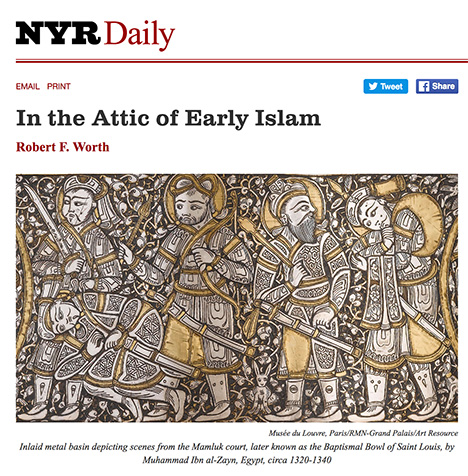There is a recent documentary on the Zabbalin garbage collectors of Cairo, produced by RT.
Category Archives: Countries
Persian Muscle Men

Following the Iranian Revolution of 1979, the sporting activities in the Zurkhaneh were declared inappropriate. Nowadays, however, they have become a symbol of Iranian national pride.
Persia’s “power houses” packed a punch
Qantara
Varzesh-e Zurkhaneh-i, (literally, the sport of heroes in the house of power). The ancient Iranian Zurkhaneh gymnasia have their roots in customs and traditions that date back to the country’s pre-Islamic past. This selection of early photographs portrays the world of the Zurkhaneh athletes from 1789 to 1925.
Al-Nuwayri on the Pleasures of Life
A post about the famous 14th century Mamluk text of al-Nuwayri, with a new English translation of excerpts from this classic compendium now available.
Weapons of the Syrian War
For an animated video of the weapons used by all sides in Syria, click here.
by Ben Watson, Defense One, July 19, 2016
From chlorine gas to Kalashnikovs, barrel bombs to cruise missiles, the Syrian conflict shows what 21st-century militaries and armed groups can bring to bear.
The Assad regime’s bloody reaction to the 2011 Arab Spring ignited one of the most lethal rebellions in modern history, placing it in the crosshairs of more than 1,000 armed groups: rebels, Kurds, defectors, extremists and countless others, including foreign military experts. Taken together, the opposition is better equipped than any the world has seen in generations, according to Charles Lister, Middle East analyst and resident fellow at the Middle East Institute.
“Syria represents the Afghanistan of the 21st century, but on steroids. The scale of jihadist militancy in Syria is one thing; the capability that they have acquired,†Lister said, “is at least in my opinion unprecedented in modern history.â€
The weapons on display in the Syrian war include some of the world’s most advanced and deadly, thanks to the U.S.-led campaign against the Islamic State and Russia’s own arrival in 2015.
Hundreds of thousands of people have died in the war; the UN stopped counting at 191,000 three years ago, but estimates range from a quarter million to at least 470,000. The conflict has uprooted half of Syria’s pre-war population, scattering five million people beyond its borders.
Reforming Saudi Arabia?
Mystique of Monarchy
Post-War Watch – April 19, 2016
https://postwarwatch.com/2016/04/19/mystique-of-monarchy/
MADAWI AL-RASHEED — Limited social and political reforms in Saudi Arabia only prolong the life of authoritarianism.
Although Saudi Arabia’s government relies on the religious establishment for its legitimacy, there are multiple groups and factions that fall under the Islamist category. How does the monarchy understand the relationship between Saudi’s religious establishment and political governance?
The dynamic at the heart of this question is better understood as one between religion and politics within the Kingdom of Saudi Arabia. The relationship between these two spheres has evolved through the twentieth century. There is not one way of describing the interaction between religious and political entities, simply because it is subject to the political will of the regime — and the government’s evolving connection to official Islam and Islamists’ discourses and practices. Ultimately, this relationship has gone through three distinct phases since the consolidation of the modern state
The first phase (1960s-1990s) can be described as one of cooperation and instrumentalization. Since the establishment of the modern Saudi kingdom in 1932, the al-Saud political leadership tried to cooperate with the religious establishment in their country. The royal family institutionalized their discourse by creating specific religious bodies and honoring key figures for their support of the regime. Saudi Arabia’s government claimed legitimacy as the leadership that applies Islamic law and protects the Holy Cities — as well as directs outreach to Muslim communities around the globe. The regime’s efforts to incentivize religious bodies to support the monarchy derived potency from the fact that Saudi’s religious groups operated according to a populist ethos: religious figures can reach people in mosques, schools, universities, as well as exercise control over the judiciary.
The second phase began in the early-1990s, following the 1990-1991 Iraqi invasion of Kuwait. During this period the Saudi regime alternately repressed and accommodated opinions from the multiple voices within the religious establishment and the splinter groups around it. Saddam Hussein’s military operations posed a serious threat to Saudi Arabia’s security and economy. The royal family understood that it needed to bring foreign, non-Muslim soldiers onto Saudi soil to defend the Kingdom — an action that angered conservative religious elements. Immediately after the Iraqi invasion, the Saudi regime began repressing Islamist voices that dissented against cooperation with United States and other foreign militaries.
On Drones
Seasonal Knowledge in the Gulf Project
This is to note that I have received a research grant from the Qatar Foundation for a study of indigenous knowledge of the seasons and time-telling in the Gulf. I have created a separate webpage to indicate progress through updates on the progress. This page is at https://tabsir.net/?page_id=2903
Women of Iran’s Past
The women of Iran – 120 years ago
Antoin Sevruguin, the father of Iranian society photography, captured portraits of Iranian women in the early 20th century, from well-known ladies at the court to women from various tribes around the country.
Click here to see the photographs.






